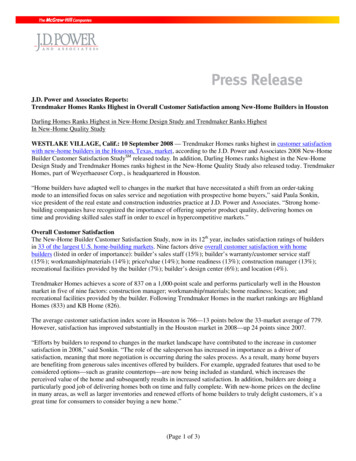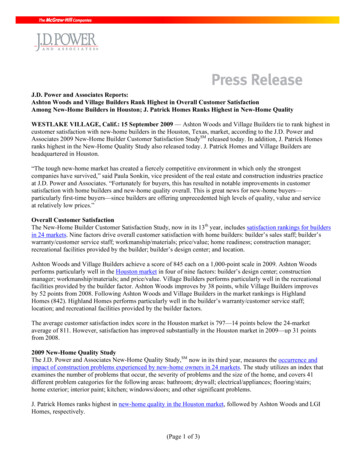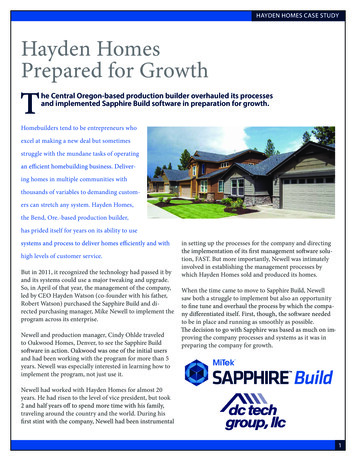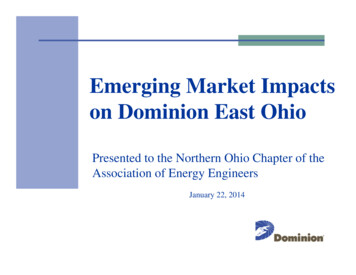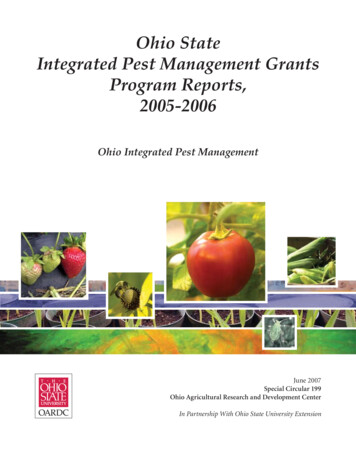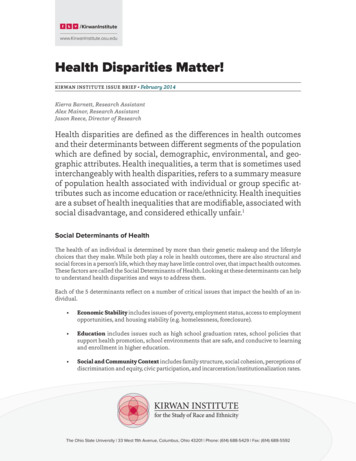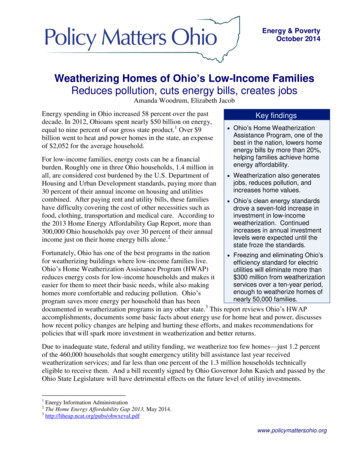
Transcription
Energy & PovertyOctober 2014Weatherizing Homes of Ohio’s Low-Income FamiliesReduces pollution, cuts energy bills, creates jobsAmanda Woodrum, Elizabeth JacobEnergy spending in Ohio increased 58 percent over the pastdecade. In 2012, Ohioans spent nearly 50 billion on energy,equal to nine percent of our gross state product.1 Over 9billion went to heat and power homes in the state, an expenseof 2,052 for the average household.For low-income families, energy costs can be a financialburden. Roughly one in three Ohio households, 1.4 million inall, are considered cost burdened by the U.S. Department ofHousing and Urban Development standards, paying more than30 percent of their annual income on housing and utilitiescombined. After paying rent and utility bills, these familieshave difficulty covering the cost of other necessities such asfood, clothing, transportation and medical care. According tothe 2013 Home Energy Affordability Gap Report, more than300,000 Ohio households pay over 30 percent of their annualincome just on their home energy bills alone.2Key findings Ohio’s Home WeatherizationAssistance Program, one of thebest in the nation, lowers homeenergy bills by more than 20%,helping families achieve homeenergy affordability. Weatherization also generatesjobs, reduces pollution, andincreases home values. Ohio’s clean energy standardsdrove a seven-fold increase ininvestment in low-incomeweatherization. Continuedincreases in annual investmentlevels were expected until thestate froze the standards.Fortunately, Ohio has one of the best programs in the nation Freezing and eliminating Ohio’sfor weatherizing buildings where low-income families live.efficiency standard for electricOhio’s Home Weatherization Assistance Program (HWAP)utilities will eliminate more thanreduces energy costs for low-income households and makes it 300 million from weatherizationservices over a ten-year period,easier for them to meet their basic needs, while also makingenough to weatherize homes ofhomes more comfortable and reducing pollution. Ohio’snearly 50,000 families.program saves more energy per household than has been3documented in weatherization programs in any other state. This report reviews Ohio’s HWAPaccomplishments, documents some basic facts about energy use for home heat and power, discusseshow recent policy changes are helping and hurting these efforts, and makes recommendations forpolicies that will spark more investment in weatherization and better returns.Due to inadequate state, federal and utility funding, we weatherize too few homes—just 1.2 percentof the 460,000 households that sought emergency utility bill assistance last year receivedweatherization services; and far less than one percent of the 1.3 million households technicallyeligible to receive them. And a bill recently signed by Ohio Governor John Kasich and passed by theOhio State Legislature will have detrimental effects on the future level of utility investments.1Energy Information AdministrationThe Home Energy Affordability Gap 2013, May .policymattersohio.org
Low-Income WeatherizationIn 2008, Ohio put in place an effective standard that requires investor-owned electric utilities toreduce electric energy consumption in their territory by 22 percent by 2025. Since 2008, the standardhas driven a seven-fold increase in electric utility investments in low-income home weatherization.In late spring of 2014, however, Governor John Kasich signed into law a bill freezing that energystandard for two years while assessing whether to eliminate it altogether. Eliminating the standard, orminimizing it, would result in dramatic cuts to already modest low-income weatherization programs.Based on current spending trajectories, the freeze and future elimination of Ohio’s energy efficiencystandard for electric utilities would result in the loss of more than 300 million in estimatedinvestments in low-income weatherization services, enough to weatherize nearly 50,000 homes overthe next ten years. The state should restore Ohio’s standard and further incentivize utilities to investin low-income weatherization to meet requirements.Ohio would benefit greatly from increased state, federal and utility investments in weatherization.They more than pay for themselves. According to the U.S. Department of Energy, every 1 investedin HWAP generates 2.51 in energy savings and related benefits— 1.80 in reduced energy bills plus71 cents in benefits to ratepayers, households, and communities.4 When low-income householdscannot afford their utility bills, much of the cost is born by other ratepayers through increased rates.Weatherization not only reduces utility bills for low-income households, it also shrinks utility debtand lowers rates for all households, improves the health and safety of homes, lessens reliance onimported energy, reduces harmful emissions, and increases employment. For every 1 millioninvested in weatherization, 52 direct jobs and 23 indirect jobs are created, many of which go tolower-income workers. 5Home Energy AssistanceHeat and electric power are basic necessities. To keep the heat on and power flowing, low-incomefamilies are often forced to cut back on other necessities and seek public assistance. Thesehouseholds face a difficult choice between eating properly, purchasing medication, or heating theirhomes. Each year, hundreds of thousands of Ohioans seek public assistance in paying utility bills.In 2012, more than 440 million in public dollars went to provide utility bill assistance to low-incomefamilies: 162.7 million in emergency assistance from the federal government to help 460,000 Ohiofamilies cope with a winter or summer crisis and 277.5 million in ratepayer dollars to help 350,000low-income households reduce their monthly utility bill to six percent of household income.However, relatively few households are weatherized each year. Table 1 shows that in 2012, 5,741homes were weatherized, less than one percent of the 460,000 households that sought emergencyenergy bill assistance that year and far less than one percent of the 1.3 million households technicallyeligible to receive weatherization services. It also provides basic information on the state of Ohio’sprograms dedicated to making home energy bills more affordable for low-income families.4Weatherization Assistance Program, Know the Facts,http://www.waptac.org/data/files/website docs/public information/know%20the%20facts may2012.pdf5Ohio Partners for Affordable Energy, Ohio Home Weatherization Assistance Program Paper2www.policymattersohio.org
Low-Income WeatherizationTable 1Relatively Few Households Seeking Assistance Receive Weatherization ServicesHome EnergyAssistance ProgramPercentage IncomePayment Plan (PIPP)Home WeatherizationProgram (HWAP)Electric PartnershipProgram (EPP)2012Expenditures# ofHouseholdsServed 162,739,126459,057 277,456,844358,000Weatherization Services 38,089,2465,741Installs efficient lights, appliances;some weatherization services 15,000,00012,519Program TypeEmergency bill assistance forWinter and Summer CrisesSubsidized bill payment planbased on ability to payEligibilityRequirementsAt or below175% of FPLAt or below150% of FPLAt or below200% of FPLAt or below150% of FPL# of ,121,054Ohio’s Home Energy Assistance Program (HEAP) is federally funded through the Low Income Home EnergyAssistance Program (LIHEAP) and administered by the Ohio Office of Community Assistance in the OhioDevelopment Services Agency. HEAP is a one-time benefit, administered during a crisis, typically applied as a creditto the utility bill.1 The average HEAP benefit was 217 in 2013 ( 277 for a winter crisis and 171 for summer crisis).The size of the benefit depends on several factors: number of persons in home, total household income, primary fuelused to heat home, and federal funding.The Percentage of Income Payment Plan (PIPP) plus program is available year round to electric and natural gascustomers with incomes under 150 percent of the federal poverty line. Those electing to enroll in the program makemonthly utility payments of 10 or 6 percent of household income, whichever is greater. The state then reimbursesthe utility for any payment due that is over and above the income-based payment made. PIPP customers can alsoreduce old debt by paying their monthly PIPP payments on time and in full.Home Weatherization Assistance Program (HWAP)’s primary objectives are to increase the energy efficiency ofhomes of low-income renters or owners, reduce participants’ total residential energy expenditure, and improveparticipants’ health and safety1. The HWAP receives funding from a mix of federal Department of Energy funds andappropriations from the state Home Energy Assistance Program (HEAP). The state’s HWAP sets the technicalstandard for energy efficiency programs offered by Ohio’s utility companies.Electric Partnership Program (EPP) was enacted in 1999 as a result of electric restructuring legislation in Ohio.The program, funded by the Universal Service Fund, aims to reduce electric consumption by households in the PIPPprogram. The EPP has two major components: 1) A base load efficiency program which audits lights, appliancesand other uses of electricity not related to heating and cooling, and installs appropriate measures 2) Aweatherization program for those who heat with electricity and who have moderate to high usage. This programadds insulation, performs heating system inspections and addresses health and safety measures.1 While most of theuniversal service rider revenues fund PIPP, approximately 15 million is reserved each year for the ElectricPartnership Program.Ohio HWAP Network also Manages Efficiency Programs for Utilities. Ohio leads other states in combiningfederal weatherization funds with utility resources and other housing rehabilitation funds to provide comprehensiveservices to low-income families. The current HWAP network also manages programs for all seven major utilities(both gas and electric). This approach enhances household savings and saves ratepayers money.Source: Ohio Development Services Agency, Ohio Consumers’ Counsel, Ohio Partners for Affordable Energy, Bureau of Economic Analysis*FPL stands for Federal Poverty Line.3www.policymattersohio.org
Low-Income WeatherizationHome Weatherization Assistance Program (HWAP)Many low-income families live in older homes with inadequate insulation and inefficient appliances,contributing to high levels of energy use and large utility bills. Ohio’s Home WeatherizationAssistance Program increases the energy efficiency of homes of low-income renters or owners andpermanently reduces energy bills.6 Recipient households receive the following weatherization andefficiency services:71. An inspection or audit to determine what energy-efficiencyTable 2measures are appropriateIncome guidelines2. Energy educationfor HWAP3. Installation of weatherization services and necessary health andSize of Family 200% of FPLsafety measures including: Wall, attic and floor insulation;1 23,340blower-door guided air sealing; heating system safety tests,2 31,460repairs and tune-ups; duct insulation and sealing; hot-water8savings measures; and energy related home repairs.3 39,5804. Final inspection of installation.4 47,700To qualify, households must be at or below 200 percent of the federalpoverty guidelines, as shown in Table 3. Nearly 1.4 million householdsin Ohio qualify. Since weatherization funds are so limited, priority isgiven to the elderly, those with disabilities, families with children, andhouseholds with high energy burdens.956 55,820 63,940Source:https://development.ohio.gov/is/is hwap.htmAccording to the 2013 Home Energy Affordability Gap Report, over 300,000 Ohio households withincomes at or below 50 percent of the federal poverty level pay 31 percent of their annual income onhome energy bills.10 More than 377,000 households living with incomes between 50% and 100% ofthe federal poverty level, face a home energy burden of 16%.Rental housing services: a unique feature of HWAPRental units represent a significant portion of homes weatherized in Ohio, a unique feature of the efficiencyprogram. Rental housing typically faces a split incentive when it comes to investing in weatherization,ultimately leading to inaction on the part of both the tenant and landlord. Since nine out of ten tenants inOhio pay their own energy bills while the landlord owns the building, neither the tenant nor the landlord hasan incentive to invest in the building to permanently reduce energy bills.To ensure weatherization benefits both the low-income tenant and landlord and to spur action, Ohio HWAPadopted the following policy: Weatherization services are largely free to both landlord and tenant.However, landlords contribute 50 percent of cost of any health and safety measures unless the landlord fallswithin the federal poverty level guidelines. If the landlord pays utility costs, then half the cost ofweatherization materials is also required of the landlord. For one year, post-weatherization, the propertyowner must agree not to raise the rent as a result of the weatherization performed on the house.Source: Home Weatherization Assistance Program 2014 State Plan6M. Sami Khawaja et al., Quantec, LLC, Ohio Home Weatherization Assistance Program Impact Evaluation, 2006Id.8Blasnik and Downey of Proctor; Hill, Introclo, and Nichols of Tellus; and Jones of Residential Building Analysis,Ohio’s Home Weatherization Assistance Program: An Independent Evaluation, er, Sheehan & Colton, Ohio Home Energy Affordability Gap 2013 (May 2014)74www.policymattersohio.org
Low-Income WeatherizationHWAP State and Federal FundingHWAP receives funding from the federal Department of Energy (DOE) and an appropriation fromthe state of Ohio’s federal Home Energy Assistance Program (HEAP) dollars. Per federal rules, up to20 percent of a state’s HEAP budget can be appropriated to the Home Weatherization Assistanceprogram, and Ohio consistently transfers 15 percent.11 Table 4 shows the level of funding and thenumber of homes weatherized over a ten-year period. OnTable 3average, the state of Ohio weatherizes roughly 7,000 homesHistorical HWAP fundingeach year, only about 1.5 percent of the 459,000 households# Homesseeking emergency assistance for help with their utility bills.In 2009, however, the American Reinvestment and RecoveryAct (ARRA), also known as the federal stimulus package,temporarily expanded the Weatherization Assistance Programacross the nation.12 Ohio received 289 million of 5 billiondollars committed nationally. ARRA also changed a numberof existing provisions for weatherization, notably: requiringweatherization workers be paid “prevailing wages”; expandingthe income eligibility level from 150 percent to 200 percent ofthe federal poverty level; increasing the average assistancelevel per home from 2,500 to 6,500; and doubling allowablefunding for 2Total Funding 28,369,727 27,742,752 29,627,500 36,744,248 32,368,880 37,509,012 53,633,503 288,677,576 41,057,474 72,19940,1983,9775,741During ARRA’s three-year period, more than 40,000 homes in Source: Ohio Development ServicesOhio were weatherized with federal stimulus funds. Table 5shows average household savings during that period ranging between 540 and 620, with a netpresent value of the total lifetime energy savings of measures installed amounting to over 10,000 perhousehold. Among other benefits, in addition to household energy savings, approximately 1,200 Ohioresidents were hired and trained to do the work.14 Unfortunately, because ARRA funds weretemporary, nearly 900 of those workers later lost their jobs, emphasizing the need for a sustainableand consistent source of funding. On a positive note, 300 of the original 1,200 were retained to meetincreasing utility investments in weatherization resulting from Ohio’s energy efficiency requirement.Table 4Energy Costs and Benefits from ARRA WeatherizationPrincipal factors considered (per household)EstimatesAverage heating and cooling bill reduction 440Savings in electricity bills for electric appliances 100- 180Average cost of weatherizing a house unit under the program 5,760Net present value of energy savings 10,350Energy benefit cost ratio1.8Source: Oak Ridge National Laboratory11M. Sami Khawaja et al., Quantec, LLC, Ohio Home Weatherization Assistance Program Impact Evaluation, 2006http://weatherization.ornl.gov/pdfs/ORNL TM-2010-66.pdf13United States Government Accountability Office, Recovery Act: Progress and Challenges in Spending WeatherizationFunds, 201114Sarah Robinson, ARRA’s Home Weatherization Assistance Program, 2010125www.policymattersohio.org
Low-Income WeatherizationOhio’s Weatherization Network also Manages Low-income Energy Efficiency Programs forOhio’s Utilities.Ohio’s HWAP network also manages low-income efficiency programs for all seven major utilities inthe state (both gas and electric companies), and for a number of smaller gas utilities, an approach thatenhances household savings and saves ratepayer money. The majority of electricity and natural gasservices in the United States are provided by investor-owned utilities (private companies withstockholders typically regulated by state public service commissions). Figure 1 below shows themany sources supporting Ohio’s weatherization network, the largest source being federal HWAPdollars, which peaked during the three-year federal stimulus period from 2009 to 2011.Figure 1Ohio Weatherization Network Receives Funding from Range of SourcesLow Income Weatherization Funding --All enEPPHWAP20122011201020092008 - 50,000,000 100,000,000 150,000,000 200,000,000Source: Ohio Partners for Affordable EnergyOhio’s Clean Energy Law Drives Utility Investments.Roughly half of the states, including Ohio, have laws and regulations in place requiring utilities toinvest in energy efficiency programs. Ohio’s efficiency standard, prior to being frozen by GovernorKasich and the state legislature, required electric utilities to achieve a 22 percent reduction in energyconsumption by 2025 (starting at 0.3 percent annual savings in 2009, ramping up to one percentannually in 2014 and two percent in 2019).Table 7 below shows that as Ohio’s efficiency requirements ramped up, utility investments in lowincome weatherization increased dramatically. Since Ohio’s efficiency standards were enacted,electric utility investments increased seven-fold. In 2012 alone, to meet energy efficiencyrequirements, Ohio’s electric utilities invested approximately 249 million in efficiency services, sixpercent of which went towards low-income weatherization programs. In 2013, Ohio ranked 18th inthe nation for its energy efficiency policies and was the most improved state (according to theAmerican Council for an Energy-Efficiency Economy’s 2013 State Energy Efficiency Scorecard).Unfortunately, since then, Ohio became the first state to roll back its efficiency requirement forelectric utilities. Governor Kasich signed a bill essentially freezing Ohio’s efficiency standard for twoyears while the legislature debates whether to eliminate the standard altogether. This is a hugesetback for Ohio’s clean energy economy and for low-income weatherization programming.6www.policymattersohio.org
Low-Income WeatherizationTable 5Utility Investment in low-income weatherizationElectric Utility Energy SavingsRequirements (by 9%American 590,000 12,270,000 8,790,000 11,604,000Electric utility Electric Power DaytonPowerInvestments in 265,000 1,000,000 1,000,000 1,000,000 1,000,000 1,000,000Low-Income & Light 350,000 365,000Weatherization Duke(by year)FirstEnergy 2,100,000 5,000,000 5,000,000 5,000,000 5,000,000 5,000,000Total 2,365,000 6,000,000 6,590,000 18,270,000 15,140,000 17,969,000American ElectricThe Community Assistance Program allows customers with low or fixed incomes toPowerreceive weatherization assistance. Energy efficiency measures include: home energyassessment, attic and wall insulation, air sealing, CFLs, and refrigerator replacement.The Community Assistance Program saves energy for residential low-incomecustomers through electric measures and weatherization upgrades.Dayton Power & Light Residential Low Income Affordability program identifies and implements energyefficiency measures in qualifying homes to reduce energy bills and debts, and increaseenergy savings. In 2009, DP&L provided efficiency services to roughly 850 low-incomehouseholds.Duke EnergyDuke Energy provides some energy efficiency services to low-income customers,including furnace or heat pump clean and tune, energy-efficient light bulbs, energysaving tips, hot water heater wrap, weather stripping, pipe wrap, duct sealing, wall andattic insulation and other air leakage sealing measures. Low Income NeighborhoodProgram aims to reduce energy consumption by directly installing measures andeducating the customers on better ways to manage their energy bills. Low IncomeServices offers a refrigerator replacement program.First EnergyCommunity Connections program provides weatherization, client education, andenergy efficient products and services to low-income customers.Sources: Policy Matters, data compiled from http://www.liheap.ncat.org/profiles/Ohio.htm, Duke Energy’s Integrated Resource Plan, DaytonPower & Light’s Energy Efficiency and Peak Energy Demand Reduction Plan, First Energy’s Energy Efficiency and Peak Energy DemandReduction Plan, and AEP’s Energy Efficiency and Peak Energy Demand Reduction Plan7www.policymattersohio.org
Low-Income WeatherizationHWAP Administration. With respect to energy savings achieved, Ohio has one of the mostsuccessful weatherization assistance programs in the country.15 According to an independentevaluation conducted in 2006, “Ohio’s HWAP program is so effective that many households don’tneed to go on [the Percent Income Payment Plan] to retain utility service.”16 Ohio also set an examplefor other states by creating a funding model combining federal weatherization funds with utilityresources and other housing rehabilitation funds to provide the most comprehensive and effectiveservices possible, discussed more in the next section. The Ohio Development Services Agencyadministers HWAP through its Office of Community Assistance (OCA). The OCA overseesweatherization providers to ensure regulations are followed and the program is effective.17 Servicesare delivered through a network of 58 community action agencies and local governmentalorganizations throughout the state, in partnership with local, independent contractors. Weatherizationproviders are trained at the Ohio Weatherization Training Center run by the Corporation for OhioAppalachian Development.18HWAP Outcomes. Nationally, for every 1 invested in the Low-Income Weatherization AssistanceProgram, weatherization returns 2.51 to the household and economy: 1.80 to the householdthrough reduce energy bills; 71 cents to ratepayers, households, and communities through fewerpayment shortfalls and uncollectible bills, decreases in heat-related illness and death, reduced risk ofhome fires due to utility disconnection, and increased local employment. 19 On average, HWAPparticipants reduce their gas consumption by 25 percent for single-family homes and 20 percent formultifamily homes, saving low-income families 350 in reduced first-year energy costs following aHWAP project.20 Beyond energy benefits, weatherization increases property value, reduces fires,improves health and safety conditions, increases comfort for occupants, reduces homelessness, andextends the lifetime of affordable housing.21 Investments in weatherization also reduce reliance onimported energy, curb harmful greenhouse gas emissions, and increase employment.Investments in HWAP create jobs, many of which pay relatively decent wages. For every 1 millioninvested in weatherization, 52 direct jobs and 23 indirect jobs are created. 22 Basic weatherizationincludes minor repairs, blowing and batting insulation, window and door repair, weather stripping,solar film installation, air sealing, caulking, minor structural repairs, air and duct sealing, light bulbinstallation, and installing smoke detectors. Special weatherization work, usually done by qualifiedindependent local contractors, includes door and window replacement, installation or repair offurnace/cooling system (HVAC) and related electrical, pipe and duct work. Weatherization jobs don’tpay as well as many building trades positions, but they pay above minimum wage. Table 6 detailsprevailing wages for both general and special work related to weatherization jobs, based on a surveyconducted for 2010 ARRA purposes. Table 6, below, shows official prevailing wages compiled bythe Department of Labor for weatherization and related work across Ohio. 2315M. Sami Khawaja et al., Quantec, LLC, Ohio Home Weatherization Assistance Program Impact Evaluation, 2006Id17https://development.ohio.gov/is/is hwap.htm18Michael Blasnik and Tom Downey of Proctor; David Hill, Shawn Introclo, and David Nichols of Tellus; and DonMichael Jones of Residential Building Analysis, Ohio’s Home Weatherization Assistance Program: An IndependentEvaluation, http://liheap.ncat.org/pubs/ohwxeval.pdf19M. Sami Khawaja et al., Quantec, LLC, Ohio Home Weatherization Assistance Program Impact Evaluation, 200620Ohio Partners for Affordable Energy, Ohio Home Weatherization Assistance Program White Paper21Id.22Id.23Dept. of Labor, Wage and Hour Division, Ohio Residential Weatherization Wage Determination168www.policymattersohio.org
Low-Income WeatherizationTable 62010 Ohio prevailing wages in weatherization and related workExisting Residential Wage(www.wdol.gov)Weatherization ffersonKnox9WeatherizationWorker 10.54 10.80 10.95 9.49 10.28 7.35 11.75 10.36 10.80 10.88 10.00 10.00 13.45 10.00 13.88 10.58 9.49 13.32 10.00 10.00 11.12 9.00 11.12 16.00 9.75 16.79 7.30 10.28 10.88 8.32 12.47 10.95 10.95 8.32 11.12 9.97 7.35 9.49 10.95 10.25 10.17 9.49Doors &WindowsReplacementWorker 10.72 10.80 10.95 9.50 10.28 7.35 12.50 10.36 10.80 10.88 10.00 10.00 13.45 10.00 13.88 10.58 9.49 13.32 10.00 10.00 11.12 9.00 11.12 16.00 9.75 21.25 7.30 10.28 10.88 8.32 12.47 10.95 10.95 8.32 11.12 9.97 7.35 9.48 10.95 10.25 10.17 9.51HVAC, Furnace,Heating &Cooling Repair,Installation 14.46 17.20 17.75 12.79 14.88 8.36 12.79 13.42 16.73 17.75 13.42 12.79 21.00 16.73 13.08 10.56 12.14 12.79 20.00 12.79 12.79 13.29 26.50 13.29 17.00 18.96 11.45 14.88 17.75 9.49 17.75 12.79 12.79 9.49 12.79 17.00 8.36 8.23 12.79 12.00 13.42 12.79CarpenterElectricianPlumber 12.78 13.58 13.78 12.03 7.63 12.03 21.30 12.03 7.63 15.18 15.33 15.33 15.18 12.03 15.33 15.33 12.03 13.23 12.03 10.18 16.13 12.03 12.03 7.61 12.03 7.61 12.03 7.61 12.03 21.30 15.33 12.03 15.33 12.03 12.03 12.03 12.03 12.03 12.03 12.03 12.03 12.03 15.18 12.03 12.69 7.62 12.69 29.15 12.69 7.62 11.50 17.00 17.00 16.20 12.69 16.25 17.00 12.69 13.00 12.69 11.22 18.55 12.69 12.69 8.53 12.69 8.53 12.69 8.53 12.69 18.55 17.00 12.69 17.00 12.69 12.69 12.69 12.69 12.69 12.69 12.69 12.69 12.69 16.20 12.69 13.40 8.68 13.40 21.84 13.40 8.68 17.90 12.26 12.26 17.90 13.40 12.26 12.26 13.40 12.94 13.40 12.05 21.84 13.40 13.40 9.02 13.40 9.02 13.40 9.02 13.40 21.84 12.26 13.40 12.26 13.40 13.40 13.40 13.40 13.40 13.40 13.40 13.40 13.40 17.90 13.40www.policymattersohio.org
Low-Income WeatherizationLake 10.28 10.28 14.88 21.30Lawrence 8.78 8.78 11.45 15.33Licking 10.66 10.66 13.29 7.61Logan 10.00 10.00 12.79 12.03Lorain 12.06 12.06 14.88 16.13Lucas 11.00 11.00 26.50 21.20Madison 9.00 9.00 13.29 7.61Mahoning 8.50 8.50 14.00 14.65Marion 13.32 13.32 12.79 12.03Medina 11.47 12.57 16.03 16.13Meigs 7.30 7.30 11.45 12.03Mercer 11.75 12.50 12.79 12.03Miami 14.27 14.27 17.75 15.33Monroe 8.32 8.32 9.49 12.03Montgomery 10.88 10.88 17.75 15.33Morgan 10.17 10.1713.42 12.03Morrow 10.66 10.66 13.29 12.03Muskingum 10.00 10.00 14.00 12.03Noble 8.32 8.32 9.49 12.03Ottawa 11.00 11.00 26.50 12.03Paulding 11.12 11.12 12.79 12.03Pickaway 14.68 14.68 12.26 7.61Pike 9.43 9.43 13.96 12.03Portage 9.00 9.00 14.00 15.18Preble 10.88 10.88 17.75 12.03Putnam 10.95 10.95 12.79 12.03Ross 9.97 9.97 17.00 12.03Sandusky 10.95 10.95 12.79 12.03Scioto 13.26 17.20 17.20 12.03Seneca 10.95 10.95 12.79 12.03Shelby 10.00 10.00 12.79 12.03Stark 10.00 10.00 13.42 15.18Summit 11.00 11.00 20.00 15.18Trumbull 8.50 8.50 14.00 14.65Tuscarawas 8.32 8.32 9.49 12.03Union 9.009 13.29 12.03Van Wert 9.00 11.85 12.79 12.03Vinton 10.25 10.25 12.00 12.03Warren 10.88 10.88 17.75 15.33Washington 10.17 10.17 13.42 7.25Wayne 11.47 12.57 16.03 12.03William 11.12 11.12 12.79 12.03Wood 11.12 11.12 26.50 10.35Wyandot 10.95 10.95 12.79 12.03Source: U.S. Department of herOH.htm#.ULe0bM2GBEE* incomplete data for Fulton, Perry, and Richland Counties, so not included10 29.90 13.59 8.53 12.69 11.56 21.91 8.53 16.75 12.69 11.56 12.69 12.69 17.00 12.69 17.00 12.69 12.69 12.69 12.69 12.69 12.69 8.53 12.69 19.47 12.69 12.69 12.69 12.69 12.69 12.69 12.69 15.50 19.47 16.75 12.69 12.69 12.69 12.69 17.00 7.50 12.69 12.69 7.89 12.69 21.84 12.26 9.02 13.40 17.90 20.28 9.02 17.90 13.40 17.90 13.40 13.40 12.26 13.40 12.26 13.40 13.40 13.40 13.40 13.40 13.40 9.02 13.40 17.90 13.40 13.40 13.40 13.40 13.40 13.40 13.40 17.90 21.84 17.90 13.
200% of FPL 1,397,964 Electric Partnership Program (EPP) Installs efficient lights, appliances; some weatherization services 15,000,000 12,519 At or below 150% of FPL 1,121,054 Source: Ohio Development Services Agency, Ohio Consumers' Counsel, Ohio Partners for Affordable Energy, Bureau of Economic Analysis *FPL stands for Federal Poverty Line.
